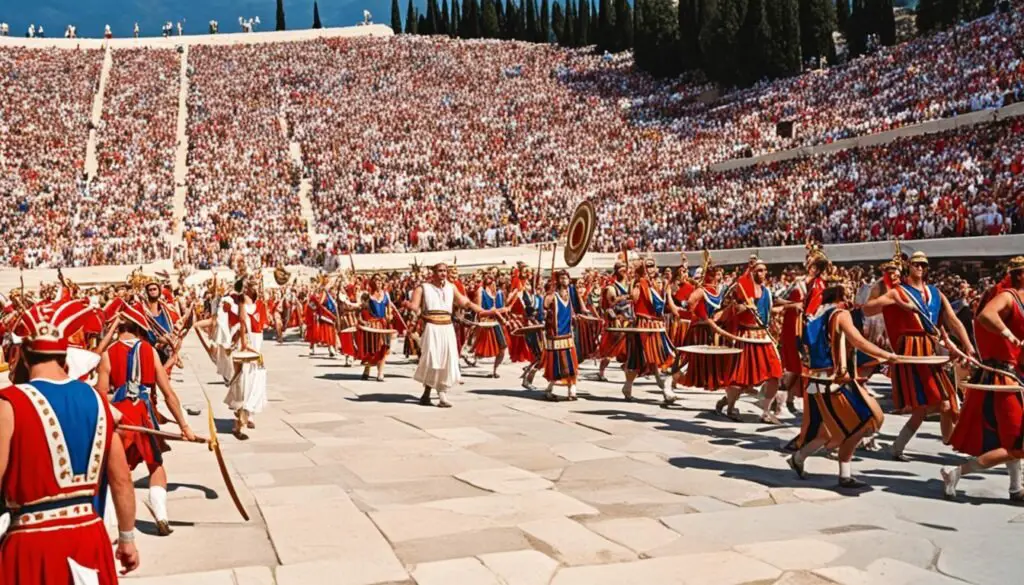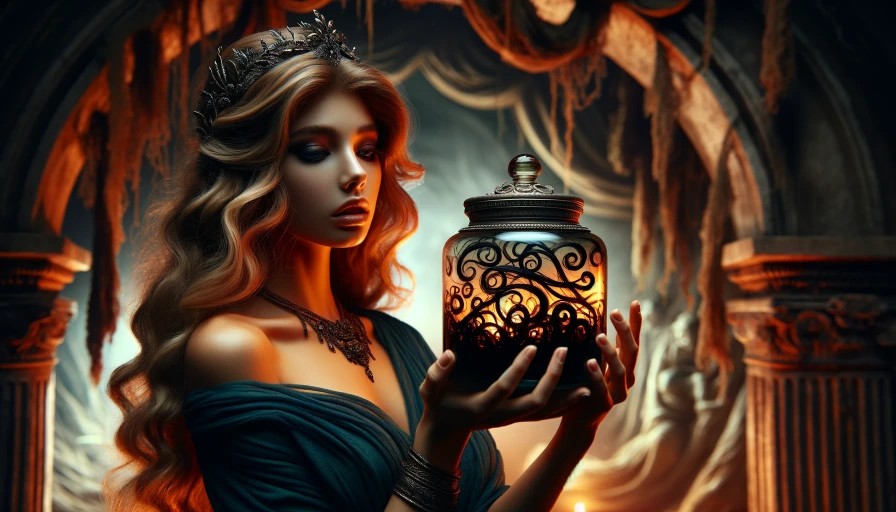The Panathenaic Festival was an annual event in ancient Athens. It celebrated Athena, the city’s patron goddess. There were two types: one each year (Lesser) and a bigger one every four years (Greater).
The Greater Festival was especially grand. It involved a large procession and the sacrifice of a hecatomb. These marks made it a key event in Athens.
The Festival started in 566 BCE. It was full of competitions and religious events. This mix became deeply rooted in Athenian life and culture.
Over time, it came to highlight Athens’ art, athleticism, and devotion to Athena. This made it a major part of how the city worshiped.
Key Takeaways
- The Panathenaic Festival honored Athena and promoted unity among Athenians.
- The Greater Panathenaic Festival, celebrated every four years, included a grand procession and hecatomb.
- Competitions ranged from musical contests to gymnasium challenges with monetary prizes for victors.
- The Panathenaic Stadium, a key venue, hosted both ancient and modern Olympic events.
- The festival was integral to Athens’ community and religious identity, continuing until the early 5th century A.D.
Introduction to the Panathenaic Festival
The Panathenaic Festival is the peak of ancient Greek celebrations. It’s closely tied to Athens’ cultural soul.
This event, in Athena’s honor, was the key festival in ancient Athens. All citizens, but not slaves, shared in its celebration.
This fest highlights Athens’ cultural and religious richness. It separated into yearly Lesser Panathenaea and the Great Panathenaea, every four years.
What was the Panathenaic Festival
The Panathenaic Festival was known as the “all Athenian” fest. It lasted from a week up to twelve days.
This festival for Athena involved music contests and sports, and its crown jewel was the torch relay race to the Acropolis.
Teams in the lampadephoria raced not to let their torches go out. They hoped to win drachmas and the honor of their tribe.
Why It Was Held
The reason for the Panathenaic Festival was to honor Athena. This made it vital to Athens’ identity, uniting Athenians and their allies.
The Greater Panathenaea, especially grand, included a procession and various rituals.
Banquets were a big part, with large feasts on the second and final days. At these feasts, meat was shared among the guests.
Historical Context
The Panathenaic Festival began in the 6th century BCE, around 566 BCE. Started by Peisistratos, it became a powerful symbol of Athens’ greatness.
It showcased sports like chariot races, poetry from Homer, and music, celebrating Athens’ achievements.
The Great Panathenaea, occurring every four years, lasted until around 410 CE. The Panathenaic Stadium, its legacy, still stands.
It has hosted the modern Olympic Games and is on Olympic medals from the 2004 Olympics.
Origins and Historical Development
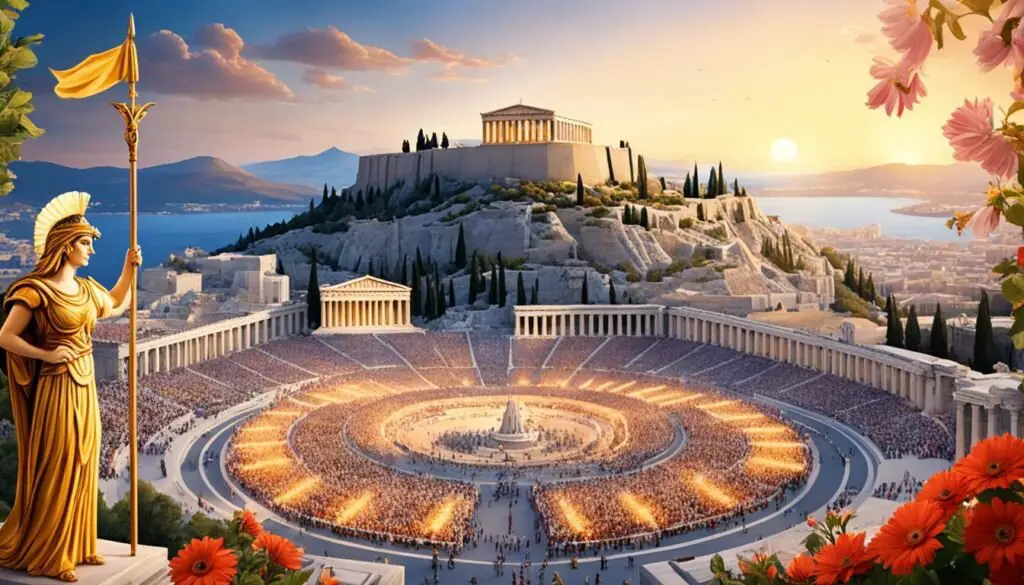
The origin of the Panathenaic Festival dates to the 8th or 9th century BCE. However its significance grew during Peisistratos’ rule in 566 BCE.
He made the festival a key part of Greek culture and politics, tying it to Athenian unity.
Early Beginnings
The start of the Panathenaic Festival enriched cultural traditions in Greece. It began as a way to honor Athena, the protector of Athens.
As years passed, it became a more vital and elaborate celebration.
Influence of Peisistratos
Peisistratos, a ruler in Athens, greatly influenced the Panathenaic Festival. He introduced the Great Panathenaic Games every four years.
This move strengthened Athens’ political and cultural power, and its residents’ shared pride and identity.
Legacy and Duration
Running for almost 1000 years, from 566 BCE to 395 CE, the Panathenaic Festival’s impact was huge. It left a mark on many eras of Athenian history.
The valuable prize amphorae, filled with olive oil, were evidence of Athens’ wide-reaching connections.
The amphorae, prizes for the athletes, showed Athens’ far-spread influence. The festival also included the Panathenaic Procession, underlining the city’s pride and spiritual devotion.
Its long history and influence display the festival’s deep effect on ancient Athens’ culture.
Significance of the Panathenaic Festival
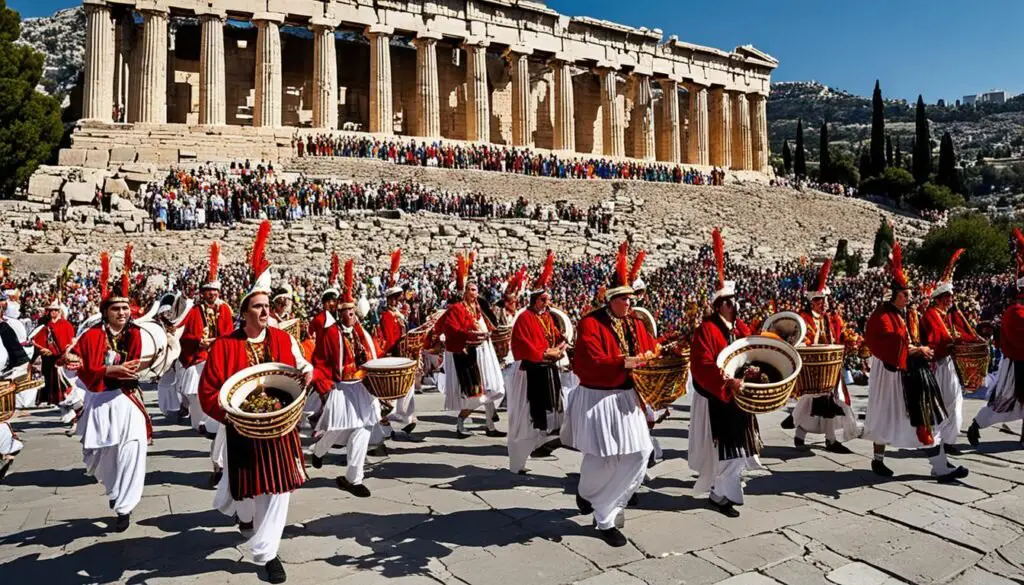
In ancient Athens, the significance of the Panathenaic Festival was huge. More than honoring Athena, it marked a major political and social event.
Starting in 566/5 B.C., this huge festival was held every four years. It showed off Athens’ riches, and culture, and brought people together.
This promoted the unity of ancient Athens unity among all its people and lands.
For twelve days, the festival was packed with events. These included sports, music, and ceremonies.
One key part was when they laid out a special garment, the people, showing a battle. This was made by the city’s women.
The celebrations also saw a mix of people, like women bringing gifts, old men with olive branches, and young riders. All this showed how everyone in Athens was united.
The Panathenaic Festival wasn’t just about Athena. It was crucial for making Athens stronger socially.
It taught people civic lessons and better connected the city and its lands. Athletes from other Greek places took part, showing how all Greeks shared a culture.
After 425 B.C., Athens’ rule stretched to other places. These areas would send gifts to show their connection to Athens.
This special festival reminded everyone of Athens’ leadership and united them. Since it happened every year for Athena, it became a big part of the city’s life.
It celebrated unity and a shared past every time.
Major Events and Activities
The Panathenaic Festival was a key part of ancient Athens, showing off its lively culture and religious beliefs.
Big parts of the festival included the parade, music contests, and sports. These activities were full of ancient Greek cultural significance.
Cultural Significance
One special part was when people read out Homeric epics. This showcased the deep tie Athenians felt with their mythical history.
The readings weren’t just fun; they also taught listeners about good morals and what it meant to be from Athens.
Many competitions and shows also demonstrated the great skills of those taking part, adding to the ancient Greek cultural significance.
Religious Activities
Central to the festival were its Greek religious events, all honoring Athena, the city’s protector.
The main event was the Panathenaic procession to the Acropolis. During this march, a new garment for the ancient wooden Athena was carried.
Another religious act was the sacrifice of 100 bulls, showing the festival’s strong religious side.
Social Impacts
The Panathenaic Festival played a big role beyond its Greek religious events. It brought Athenians together.
The march welcomed all, including some women, tightening the community. Some things, like entry through the Propylaea gates, were for citizens only, highlighting the honor of Athenian citizenship.
Also, the festival made space for people to come together and have fun as a group.
These elements were crucial for keeping Athens’ society strong and linked.
The Panathenaic Procession

The Panathenaic Festival was a time for Athenians to show off their civic pride and devotion. People from all parts of life came together in a grand event.
It showed how everyone was united in honoring the goddess Athena.
The Acropolis ceremony was filled with different groups, like young girls with the people and priestesses.
There were also musicians and sacrificial animals, especially the cow. The group paraded through Athens, ending at the Acropolis with sacrifices.
This event was central to both Athens’ religion and its community spirit.
Non-Athenians also took part, like those from allied states. Their involvement boosted their ties with Athens and their shared worship of Athena.
It underlined how Athens stood out in the Greek world. The mix of civic and religious activities showed the strong cultural heart of Classical Greece.
Role of Athena in the Festival
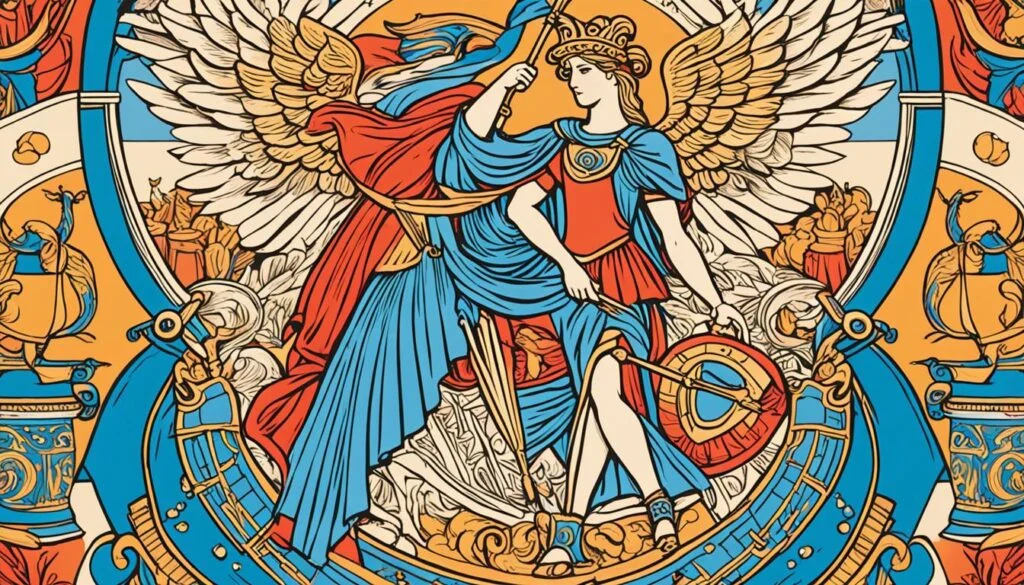
The Panathenaic Festival was all about celebrating Athena. It showed that she was not only the patron goddess of Athens but also a key part of the city’s prosperity.
As Athens’ patron goddess, she played a big role in the fest, with rites and events highlighting her as a strong, protective deity.
People brought different gifts, like small cups or big bronze statues, to honor this Greek deity.
The festival included the Panathenaic Games, happening every four years to honor Athena. Winners received special amphorai, which were honored religious symbols.
These vases often showed Athena and held the precious olive oil from trees she gave to Athens. The Boule and athlothetai carefully prepared these amphorai, showing their importance in both religion and culture.
The Panathenaic Festival started in the 7th century BCE as a birthday celebration for Athens. It involved a big yearly parade to the Acropolis.
There, a new peplos representing Athena’s protective cloak was given. This act symbolized Athena watching over the people, proving the deep respect for her in Greek culture.
The peplos were made by priestesses and girls over nine months at the festival of Khalkeia.
Events in the festival included sports, music, and poetry aimed at honoring Athena. The Panathenaea, held every four years and annually, celebrated Athena as the city’s protectress.
It was both a religious and social affair, strengthening the community and highlighting the city’s culture and history.
The Panathenaic Festival truly showed how much the people of Athens worshipped Athena. It was a key part of their life, blending her worship into the very being of their society.
Competitions and Athletic Events
In ancient Athens, the Panathenaic Festival was a huge deal. It celebrated many things, including various athletic competitions.
These events were much like the ancient Olympic Games. They highlighted strength and endurance.
Types of Competitions
The Panathenaic games had lots of athletic events for different age groups. There were events for boys aged 12-16, young men aged 16-20, and men over 20.
Big contests included chariot races, the stade race, and pankration. The pankration was a tough sport that mixed wrestling, boxing, and kicking with few rules.
- Stade Race: The winner got 100 amphoras of olive oil, equal to about $39,000 today.
- Chariot Races: Victors received about 140 amphorae of olive oil, showing the events’ high status.
- Musical Contests: This included kithara and aulos players. They won crowns and money.
Locations and Venues
Athletic contests were held at famous spots in Athens for the games. The Panathenaic Stadium and the Theatre of Dionysus were key.
They were perfect for the events and added to the festival’s splendor.
The Panathenaic Stadium saw many sports, while the Theatre of Dionysus hosted music and drama events.
These places boosted the festival’s cultural and athletic value. They brought Greek men together from all over, igniting a sense of unity and excellence.
The festival included public sacrifices and a procession celebrating Athena’s peplos. People cheered with a lot of excitement.
This has left a mark on Greek athletic events, showing their long history.
For more than eight hundred years, the Panathenaic games shaped Greek culture. They dropped in popularity in the 3rd century AD.
These contests showed off ancient Athens’ strength and culture well.
The Panathenaic Stadium
The Panathenaic Stadium in Athens is a sign of ancient Greece’s impressive design and architecture.
Today, it’s known as a top location for sports with a rich history. It was built in the 4th century BC, which is long ago.
Architectural Significance
This stadium was carefully built in its early days by Athenian leader Lycurgus. He used limestone to make it strong.
Later, in Roman times, Herodes Atticus, a rich man, spent a lot of money to make it even more beautiful.
He covered it in Pentelic marble, turning the stadium into a beautiful white jewel.
This change showed the world the Greek talent for building stunning structures.
History and Renovations
The stadium started as a simple running track. But over time, it grew to hold more people and got a new shape.
Emperor Hadrian helped make it bigger in the 2nd century AD. This made it able to fit 50,000 viewers in a new curved arrangement.
Then, in the 4th century, things changed. Emperor Theodosius stopped the old traditions at the stadium.
This led to fewer events and its slow decay. But, its story did not end there.
In the 1800s people discovered the stadium’s remains. They worked hard to bring it back to life. It was ready again for the Zappas Olympics in the 1870s and the first modern Olympics in 1896.
Since then, the Panathenaic Stadium has been a key place for sports history. It was used for archery in the 2004 Athens Olympics and the Athens Marathon each year.
These events link the old times with our sports today.
Athena’s Peplos: Symbolism and Ritual
The crafting and giving of Athena’s peplos was key in the religious practices of the Great Panathenaia.
This ritual dress was an important symbol of the city’s love and skill. It was made by noblewoman.
They then presented it to the goddess Athena during a big parade. This showed how much the people of Athens valued their traditions and beliefs.
Weaving of the Peplos
Athena’s peplos were carefully woven by noblewoman called Ergastinai. They were chosen for their high rank and religious dedication in Athenian society.
The dress was decorated with detailed patterns and stories. These celebrated the spirits and themes of the festival.
By helping make the peplos, the Ergastinai linked the people to their gods.
Presentation Ceremony
Offering Athena’s peplos was the grand moment of the Panathenaic parade. People from all levels of society took part, including Athenians, foreigners, and their allies.
The event was shown in the detailed carvings of the Parthenon frieze. It showed how the dress was given to Athena Parthenos, the goddess’ statue.
This act highlighted how important ancient Greek ritual dress was. It showed the unity and dedication among those involved.
The Parthenon’s friezes, built long ago, offer a glimpse into these lively events. The frieze doesn’t just show the parade.
It shows how people and gods joined in these festivals. The mortals were depicted as significant. They kept the divine balance by following their religious customs.
Banquets and Feasts
In Athens, the Panathenaic Festival was a time for big communal feasts. It was a weeklong celebration.
During this time, all citizens in the city would come together. This showed their unity and the good life they had.
The festival started with a big meal after sacrificing a hundred cows and sheep. This was a way to honor Athena and come together.
Everyone got a share of the meat from the sacrifices. The meat was given out by local areas within the city.
This meant every part of Athens shared in the feast. It helped everyone feel like they belonged and made the festival special for all.
The Greek banquets were more than just about the food. They showed how the city joined together.
People enjoyed music and dancing every night. This made the festival fun and unforgettable. There were also sports and poetry to enjoy.
The Panathenaic Festival was a time to embrace ancient Greek culture and have a great time.
Frequently Asked Questions
What was the purpose of the Panathenaic festival?
The Panathenaic festival was held to honor Athena, the patron goddess of Athens. It served to unite the Athenian people, showcase the city’s power and culture, and reinforce religious and civic identity.
What happened at the Panathenaia?
The Panathenaia included religious ceremonies, athletic competitions, musical contests, and a grand procession. The highlight was the presentation of a new peplos (robe) to the statue of Athena in the Parthenon.
What was the Panathenaic festival quizlet?
A Panathenaic festival quizlet would be a study aid containing questions and answers about this ancient Athenian celebration. It would likely cover the festival’s purpose, activities, and significance in ancient Greek culture.
Who did the Panathenaic festival honor?
The Panathenaic festival primarily honored Athena, the patron goddess of Athens. It celebrated her birthday and her role as the city’s protector and source of wisdom.
What is the history of the Panathenaic Games?
The Panathenaic Games were established in 566 BCE as part of the Great Panathenaea, held every four years. They included various athletic and musical contests, growing in importance and prestige over time to rival other major Greek games.
What did winners at the Panathenaic contests receive?
Winners at the Panathenaic contests received specially made Panathenaic amphorae filled with olive oil. These amphorae were decorated with images of Athena and the specific event in which the athlete had competed.
What are the activities of Panathenaic festival?
The Panathenaic festival included religious rituals, sacrifices, athletic competitions, musical and poetic contests, and a grand procession. Other activities included torch races, boat races, and the presentation of the peplos to Athena’s statue.


